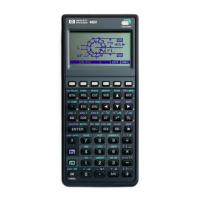
Do you have a question about the HP 48G Series and is the answer not in the manual?
| Model | HP 48G Series |
|---|---|
| Type | Graphing Calculator |
| Display Type | LCD |
| Display Size | 131x64 pixels |
| Programming Language | RPL (Reverse Polish Lisp) |
| Memory | 32 KB RAM |
| Processor | Saturn |
| Power Supply | 3x AAA batteries |
| Connectivity | Infrared (IR) |
Details initial setup procedures like turning the calculator on/off and adjusting contrast.
Introduces various mathematical objects the HP 48 can handle, like numbers, vectors, and matrices.
Explains how to input text and special characters using the Alpha keyboard and CHARS feature.
Covers navigation through menus using menu keys and the NXT key for multiple pages.
Provides an overview of different environments like Entry, Application, and Utility environments.
Explains arithmetic operations using the stack and algebraic methods.
Demonstrates how to perform calculations with fractions using the EquationWriter.
Covers symbolic calculations using algebraic objects and tick-mark delimiters.
Details how to perform operations with complex numbers in rectangular and polar forms.
Explains how to create and use unit objects for calculations involving measurements.
Shows how to convert between different measurement units using the HP 48.
Explains how memory is organized in the HP 48, including SYSRAM and variable types.
Details methods for creating global variables using the stack or Variable Browser.
Covers managing variables by organizing them into directories using the Variable Browser.
Explains how to modify existing variables and remove unneeded ones from memory.
Demonstrates how to recall and use stored variables in calculations and expressions.
Shows how to find numeric solutions for equations using the SOLVE application.
Explains how to isolate a variable symbolically by rearranging equations.
Details how to numerically calculate all real and complex roots of a polynomial.
Covers solving systems of linear equations using matrix representation.
Guides on entering and plotting functions, setting ranges, and display options.
Explains how to adjust plot options like domain, axes, and step-size.
Shows how to plot multiple functions simultaneously by creating a list.
Introduces 3D plotting concepts like View Volume and Eyepoint.
Demonstrates finding function roots visually using the PICTURE environment.
Explains how to find slope, draw tangent lines, and locate local extrema.
Covers calculating the area under a curve using the AREA command.
Explains how to find numerical and symbolic derivatives of functions.
Guides on performing numerical and symbolic integration of functions.
Introduces basic statistical analysis using matrices and calculating mean/standard deviation.
Covers fitting statistical models to data pairs and performing predictions.
Explains solving initial-value problems and plotting phase planes for differential equations.
Details commands for matrix operations like finding eigenvalues and eigenvectors.
Describes how to transfer data between HP 48 devices using the infrared port.
Shows how to access and use pre-programmed equations for science and engineering.
Explains how to install, attach, and use external libraries of commands.
Lists and explains common error messages and their meanings.
Provides steps for undoing mistakes, resetting modes, and system halts.